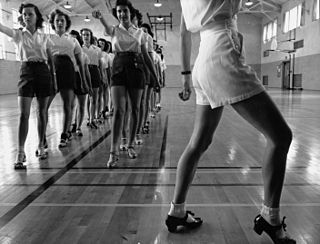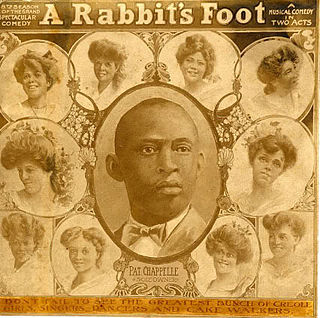
Ellas Otha Bates McDaniel, known professionally as Bo Diddley, was an American guitarist and singer who played a key role in the transition from the blues to rock and roll. He influenced many artists, including Buddy Holly, Elvis Presley, The Beatles, The Rolling Stones, The Animals, George Thorogood, Syd Barrett, and The Clash.

The jig is a form of lively folk dance in compound metre, as well as the accompanying dance tune. It first gained popularity in 16th-century England, Ireland, Scotland, and other parts of the British Isles, and was adopted on mainland Europe where it eventually became the final movement of the mature Baroque dance suite. Today it is most associated with Irish dance music, Scottish country dance and the Métis people in Canada. Jigs were originally in quadruple compound metre,, but have been adapted to a variety of time signatures, by which they are often classified into groups, including double jigs, slip jigs and single jigs.

Tap dance is a form of dance characterized by using the sounds of tap shoes striking the floor as a form of percussion. Two major variations on tap dance exist: rhythm (jazz) tap and Broadway tap. Broadway tap focuses on dance; it is widely performed in musical theater. Rhythm tap focuses on musicality, and practitioners consider themselves to be a part of the jazz tradition.

Country–western dance encompasses any of the dance forms or styles which are typically danced to country-western music, and which are stylistically associated with American country and/or western traditions. Many are descended from dances brought to the United States by immigrants from the United Kingdom and Europe as early as the 1700s, which became integrated into American popular culture. Country dancing is also known as "kicker dancing" in Texas.

Step dance is a generic term for dance styles in which footwork is considered to be the most important part of the dance and limb movements and styling are either restricted or considered irrelevant.
The United States of America is the home of the hip hop dance, salsa, swing, tap dance and its derivative Rock and Roll, and modern square dance and one of the major centers for modern dance. There is a variety of social dance and performance or concert dance forms with also a range of traditions of Native American dances.

Master Juba was an African-American dancer active in the 1840s. He was one of the first black performers in the United States to play onstage for white audiences and the only one of the era to tour with a white minstrel group. His real name was believed to be William Henry Lane, and he was also known as "Boz's Juba" following Dickens's graphic description of him in American Notes.

Robert Nathaniel Dett, often known as R. Nathaniel Dett and Nathaniel Dett, was a Canadian-American composer, organist, pianist, choral director, and music professor. Born and raised in Canada until the age of 11, he moved to the United States with his family and had most of his professional education and career there. During his lifetime he was a leading Black composer, known for his use of African-American folk songs and spirituals as the basis for choral and piano compositions in the 19th century Romantic style of Classical music.
The hand jive is a dance particularly associated with music from the 1950s, rhythm and blues in particular. It involves a complicated pattern of hand moves and claps at various parts of the body, following and/or imitating the percussion instruments. It resembles a highly elaborate version of pat-a-cake. Hand moves include thigh slapping, crossing the wrists, fist pounding, hand clapping, and hitchhike moves.
Clogging is a type of folk dance practiced in the United States, in which the dancer's footwear is used percussively by striking the heel, the toe, or both against a floor or each other to create audible rhythms, usually to the downbeat with the heel keeping the rhythm.

Clog dancing is a form of step dance characterised by the wearing of inflexible, wooden soled clogs. Clog dancing developed into differing intricate forms both in Wales and also in the North of England. Welsh clog dancing mainly originates from various slate mines where workers would compete against each other during work breaks. Northern English traditional clog dancing originates from Lancashire, Yorkshire, County Durham, Northumberland and the Lake District.

The Bo Diddley beat is a syncopated musical rhythm that is widely used in rock and roll and pop music. The beat is named after rhythm and blues musician Bo Diddley, who introduced and popularized the beat with his self-titled debut single, "Bo Diddley", in 1955. The beat has been described as essentially the Afro-Cuban clave rhythm or based on the clave or a variation thereof.

Francis Marion Brower was an American blackface performer active in the mid-19th century. Brower began performing blackface song-and-dance acts in circuses and variety shows when he was 13. He eventually introduced the bones to his act, helping to popularize it as a blackface instrument. Brower teamed with various other performers, forming his longest association with banjoist Dan Emmett beginning in 1841. Brower earned a reputation as a gifted dancer. In 1842, Brower and Emmett moved to New York City. They were out of work by January 1843, when they teamed up with Billy Whitlock and Richard Pelham to form the Virginia Minstrels. The group was the first to perform a full minstrel show as a complete evening's entertainment. Brower pioneered the role of the endman.

"Bo Diddley" is a song by American rock and roll pioneer Bo Diddley. It introduced the rhythm that became known as the Bo Diddley beat and topped the Billboard R&B chart for two weeks in 1955. The song is included on many of Diddley's compilation albums including Bo Diddley (1958) and His Best (1997). Buddy Holly recorded a version that became his highest-charting single in the UK.

John Diamond, aka Jack or Johnny, was an Irish-American dancer and blackface minstrel performer. Diamond entered show business at age 17 and soon came to the attention of circus promoter P. T. Barnum. In less than a year, Diamond and Barnum had a falling-out, and Diamond left to perform with other blackface performers. Diamond's dance style merged elements of English, Irish, and African dance. For the most part, he performed in blackface and sang popular minstrel tunes or accompanied a singer or instrumentalist. Diamond's movements emphasized lower-body movements and rapid footwork with little movement above the waist.
Sanding, also known as sand jigging or sand dancing, is a type of dance performed as a series of slides and shuffles on a sand-strewn floor. In some instances, the sand is spread across an entire stage. In other cases, it is kept in a box that the dancer stays in throughout the dance. Originally a soft-shoe technique, scratching in sand can also add a different texture to the percussion of tap. There is no one type of shoe used to sand dance; traditional tap shoes are used alongside soft shoes and leather boots, all creating a distinctive sound. Willie "The Lion" Smith said of sanding, "You could really hear and feel the rhythm when the dancers shuffled around in a nice pair of patent-leather shoes".

Black Vaudeville is a term that specifically describes Vaudeville-era African American entertainers and the milieus of dance, music, and theatrical performances they created. Spanning the years between the 1880s and early 1930s, these acts not only brought elements and influences unique to American black culture directly to African Americans but ultimately spread them beyond to both white American society and Europe.

"Willie and the Hand Jive" is a song written by Johnny Otis and originally released as a single in 1958 by Otis, reaching #9 on the Billboard Hot 100 chart and #5 on the Billboard R&B chart. The song has a Bo Diddley beat and was partly inspired by the music sung by a chain gang Otis heard while he was touring. The lyrics are about a man who became famous for doing a dance with his hands, but the song has been accused of glorifying masturbation, though Otis always denied it. It has since been covered by numerous artists, including The Crickets, The Strangeloves, Eric Clapton, Cliff Richard, Kim Carnes, George Thorogood and The Grateful Dead. Clapton's 1974 version was released as a single and reached the Billboard Hot 100, peaking at No. 26. Thorogood's 1985 version reached No. 25 on the Billboard Rock Tracks chart.

Eccentric dance is a style of dance performance in which the moves are unconventional and individualistic. It developed as a genre in the United States in the late 19th and early 20th centuries as a result of the influence of African and exotic dancers on the traditional styles of clog and tap dancing. Instead of holding the body stiff and straight in the style of a jig, acrobatics such as flips and contortions were used in a more exuberant, expressive and idiosyncratic way.
















